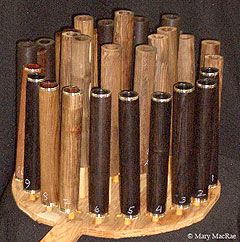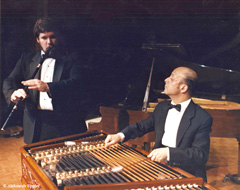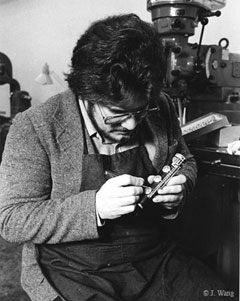
At around the age of eleven, Alexander Eppler heard the kaval being played, fell in love with it, and learned to play it. Therein began the remarkable career of a man dedicated to the fine art of both playing and making exceptional wooden instruments, including wooden flutes, cimbaloms and, of course, kavals.
In case you were wondering, the kaval is one of Europe’s oldest musical instruments, dating back at least of couple of millennia. It is an end-blown, chromatic wooden flute, usually made in three pieces, with a nearly three-octave range. “The kaval reached its highest level of development in Bulgaria,” Eppler explained, “but is found all around the area in different forms.” To create sound, you blow across the sharpened end of the mouthpiece, something that players point out takes quite a bit of practice and can be a bit frustrating for beginners.
The story of his instrument making career begins in the Pacific Northwest, where Eppler, a viola player since the age of seven, started working in a violin shop in Seattle in 1969. “The only way to get good quality work is to be patient and careful,” he says, “and they succeeded in teaching me patience. However, most of the work available was in restoration at that time, and I felt I would prefer making instruments.”

A year later, he moved to Bulgaria and went to school at the Bulgarian State Conservatory, where he studied music, kaval performance and conducting. After about 10 years of what he calls “a superb musical education,” he went to Germany and then England. While in Europe, he also learned to play cimbalom, the more sophisticated and complex forerunner of our hammered dulcimer. Unlike here, where the dulcimer is a folk instrument, the cimbalom is considered a classical concert instrument in Europe.
Within a couple of years, he returned to Seattle as an accomplished and trained musician. He toured for many years playing cimbalom, kaval and balalaika, a triangular bodied guitar-like instrument, but soon heard another calling. “I returned as a performing musician,” Eppler recounted, “but it quickly became apparent to me that the only way to survive was to tour 11 months out of the year. To have to tour all the time is not easy. In addition, I observed that in North America, people are more disposed toward paying for material things than for art.”
As a result, he settled in Seattle and opened up a shop dedicated to making and repairing wooden flutes, and making and designing cimbaloms. “Felix Skowronek, a professor at the University of Washington, is the dean of wooden flute players in America, and the man whose playing inspired me to get into high-end wooden flutes.” Today, the shop primarily makes and repairs both metal and wooden flutes and piccolos. The crew consists of Alexander (called Sasha by close friends) and three part-time assistants, a mix that in his description sounds like a fascinating multicultural experience. “In our shop,” he told me “you will hear a mixture of Russian, Bulgarian, Serbian and English spoken.”
Eppler explained that wooden flutes have far greater depth and richness of tone than the metal instruments more familiar to most of us. “They are also more complicated and more difficult to make. Boring, reaming, polishing, drying, accounting for wood movement, and all the other processes involved are more variable with wood than with metal.

“I use only a few woods on a regular basis, primarily African blackwood, cocuswood, snakewood and mopane, along with some high grade kingwood, partridge wood, cornus mas (Cornelian cherry dogwood), mountain mahogany, and oyster wood.” Some of the dense hardwoods we might think of for such work, ebony and boxwood, for example, are unstable, prone to thermal shock and hence not useful for this work. What he looks for are fine-grained, very hard woods with good dimensional stability and no open pores. Of course, they also must sound good. To subsidize the process of bringing the wood he needs through customs, he often resells some of it to others, including bagpipe makers, guitar makers and other wind instrument makers.
Building starts with a green log, which is quartered and sawn into boards, then turning blanks are split from it. Blanks are rough turned on the lathe oversized, and rough bored undersized, before being seasoned for five to 10 years. “Everything is hung from the ceiling to allow air to circulate around it and through it, and gravity helps keep it straight.”
Except for the pads, he makes everything from scratch, including all the keys and mechanisms as well as the body of the flutes. There is no discernable finish, per se, on the instruments, but he does use a special sealer he developed for tropical hardwoods that helps him polish the wood itself.
Not content to copy what’s been done, Eppler became an innovator as well. “I was the first one, in the early ’70s, to systematically introduce modern wooden head joints for metal flutes. By the ’90s, there were some 40 companies and makers copying them.” The head joint, the part of the flute that is blown into, is the tone generator, and has the greatest effect on both the playability and the tone characteristic of the instrument. His shop frequently retrofits flutes with these wooden head joints, adding richness and dimension to customers’ favorite flutes. “One of the unexpected bonuses is that my wooden head joints have the peculiar quality that they frequently add volume to the flute as well. To this day, I don’t understand why.”

In 1978, he invented the Eppler system kaval, a completely chromatic instrument with six additional integrated keys that he says sounds and plays better than the traditional instrument. “Traditional kavals miss a couple of notes between the lower and middle octaves. I’ve only built a few so far, but I am now actively putting them into production.” As far as he knows, no one else has started to copy his designs yet, in part because they are so different and vastly more difficult to make. He wants Bulgarian makers in the future to take the design further, so for that reason, there is no patent or trademark protection on it.
He estimates there are about 5,000 kaval players in the U.S., but Eppler sells kavals all over the world. He does it for the love of the instrument, selling only a dozen or so per year. Though not an important part of the business, it is one he cares about deeply. “Bulgaria gave me a great deal, and I humbly offer this back.”
He also offers something more elusive, and quite valuable: newly made instruments that surpass their venerable forebears. “Western musicians in particular are often way over-invested in an instrument’s history, provenance and age. The beauty of tone and the ease of playing are much more important. Your work should speak for you, without any other considerations.”
This fine instrument maker’s creations not only speak for him, they do it to music.





